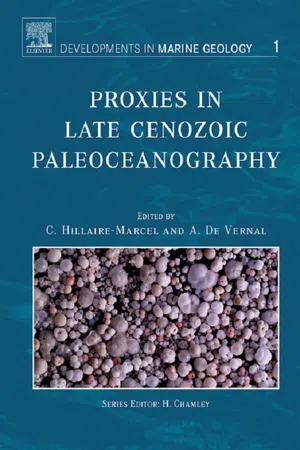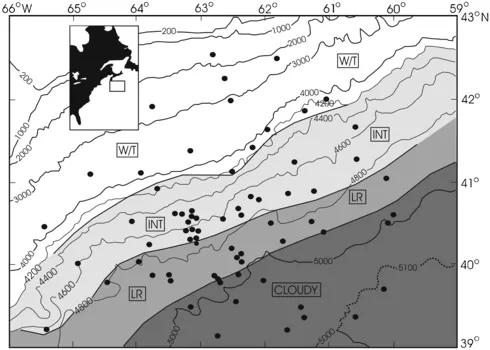
- 862 pages
- English
- ePUB (mobile friendly)
- Available on iOS & Android
Proxies in Late Cenozoic Paleoceanography
About This Book
The present volume is the first in a series of two books dedicated to the paleoceanography of the Late Cenozoic ocean. The need for an updated synthesis on paleoceanographic science is urgent, owing to the huge and very diversified progress made in this domain during the last decade. In addition, no comprehensive monography still exists in this domain. This is quite incomprehensible in view of the contribution of paleoceanographic research to our present understanding of the dynamics of the climate-ocean system. The focus on the Late Cenozoic ocean responds to two constraints. Firstly, most quantitative methods, notably those based on micropaleontological approaches, cannot be used back in time beyond a few million years at most. Secondly, the last few million years, with their strong climate oscillations, show specific high frequency changes of the ocean with a relatively reduced influcence of tectonics.
The first volume addresses quantitative methodologies to reconstruct the dynamics of the ocean andthe second, major aspects of the ocean system (thermohaline circulation, carbon cycle, productivity, sea level etc.) and will also present regional synthesis about the paleoceanography of major the oceanic basins. In both cases, the focus is the "open ocean" leaving aside nearshore processes that depend too much onlocal conditions. In this first volume, we have gathered up-to-date methodologies for the measurement and quantitative interpretation of tracers and proxies in deep sea sediments that allow reconstruction of a few key past-properties of the ocean( temperature, salinity, sea-ice cover, seasonal gradients, pH, ventilation, oceanic currents, thermohaline circulation, and paleoproductivity).
Chapters encompass physical methods (conventional grain-size studies, tomodensitometry, magnetic and mineralogical properties), most current biological proxies (planktic and benthic foraminifers, deep sea corals, diatoms, coccoliths, dinocysts and biomarkers) and key geochemical tracers (trace elements, stable isotopes, radiogenic isotopes, and U-series). Contributors to the book and members of the review panel are among the best scientists in their specialty. They represent major European and North American laboratories and thus provide a priori guarantees to the quality and updat of the entire book. Scientists and graduate students in paleoclimatology, paleoceanography, climate modeling, and undergraduate and graduate students in marine geology represent the target audience.
This volume should be of interest for scientists involved in several international programs, such as those linked to the IPCC (IODP – Integrated Ocean Drilling Program; PAGES – Past Global Changes; IMAGES – Marine Global Changes; PMIP: Paleoclimate Intercomparison Project; several IGCP projects etc.), That is, all programs that require access to time series illustrating changes in the climate-ocean system.
- Presents updated techniques and methods in paleoceanography
- Reviews the state-of-the-art interpretation of proxies used for quantitative reconstruction of the climate-ocean system
- Acts as a supplement for undergraduate and graduate courses in paleoceanography and marine geology
Frequently asked questions
Information
1 Introduction
1.1 Current Indicators in Deep-Sea Sediments
1.1.1 Photographs

1.1.2 Sedimentary structures

1.1.3 Acoustic profiles

Table of contents
- Cover image
- Title page
- Table of Contents
- Dedication
- Contributors
- Scientific Committee
- Introduction Methods in Late Cenozoic Paleoceanography: Introduction
- Chapter One Deep-Sea Sediment Deposits and Properties Controlled by Currents
- Chapter Two Continuous Physical Properties of Cored Marine Sediments
- Chapter Three Magnetic Stratigraphy in Paleoceanography: Reversals, Excursions, Paleointensity, and Secular Variation
- Chapter Four Clay Minerals, Deep Circulation and Climate
- Chapter Five Radiocarbon Dating of Deep-Sea Sediments
- Chapter Six Planktonic Foraminifera as Tracers of Past Oceanic Environments
- Chapter Seven Paleoceanographical Proxies Based on Deep-Sea Benthic Foraminiferal Assemblage Characteristics
- Chapter Eight Diatoms: From Micropaleontology to Isotope Geochemistry
- Chapter Nine Organic-Walled Dinoflagellate Cysts: Tracers of Sea-Surface Conditions
- Chapter Ten Coccolithophores: From Extant Populations to Fossil Assemblages
- Chapter Eleven Biomarkers as Paleoceanographic Proxies
- Chapter Twelve Deep-Sea Corals: New Insights to Paleoceanography
- Chapter Thirteen Transfer Functions: Methods for Quantitative Paleoceanography Based on Microfossils
- Chapter Fourteen Elemental Proxies for Palaeoclimatic and Palaeoceanographic Variability in Marine Sediments: Interpretation and Application
- Chapter Fifteen Isotopic Tracers of Water Masses and Deep Currents
- Chapter Sixteen Paleoflux and Paleocirculation from Sediment 230T and 231P/230T
- Chapter Seventeen Boron Isotopes in Marine Carbonate Sediments and the pH of the Ocean
- Chapter Eighteen The Use of Oxygen and Carbon Isotopes of Foraminifera in Paleoceanography
- Chapter Nineteen Elemental Proxies for Reconstructing Cenozoic Seawater Paleotemperatures from Calcareous Fossils
- Conclusion Reconstructing and Modeling Past Oceans
- Index of Taxa
- Subject Index